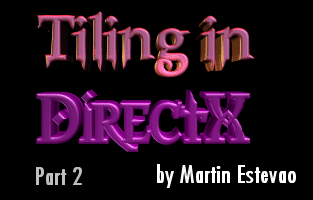11/10 - 11/12 @ Montréal, Canada
12/5 - 12/7 @ Shanghai, China
12/24 - 12/27
2/28 - 3/4 @ San Francisco, CA
More events...
2406 articles in the reference section.
Help us fight cancer!
Join SETI Team GDNet!

|
IntroductionOk, folks, welcome back! In this second installment of "Tiling in DirectX," I plan to expand on the topics presented in the first article, which you can find here. Due to lack of time I'm only going to cover smooth scrolling in this article. This might disappoint some of you, but please realize that with school and my own projects I have increasingly little time. Sorry. Smooth ScrollingIf you remember from reading Part I, we set up a simple tile engine that took a map from a 2-dimensional array and blitted the tiles to the screen using DirectDraw's BltFast(). We can't stop now! I think we're ready to take the big step into producing a scrolling world effect for your games. Don't feel that this step is daunting in any way. It's actually pretty easy once you understand the concepts. For those of us who don't know what I mean by "smooth scrolling," I am referring to the effect made when a tile-based background behind the sprites in a game moves. This creates the illusion that the main character (or whatever you are controlling in your game) is travelling from one spot of the world to another, although he may be blitted to the same location on the screen at times. Think Super Mario Bros, which is an example of a scrolling world. Get it?
|
||||||||||||||||||||
|
|
||||||||||||||||||||